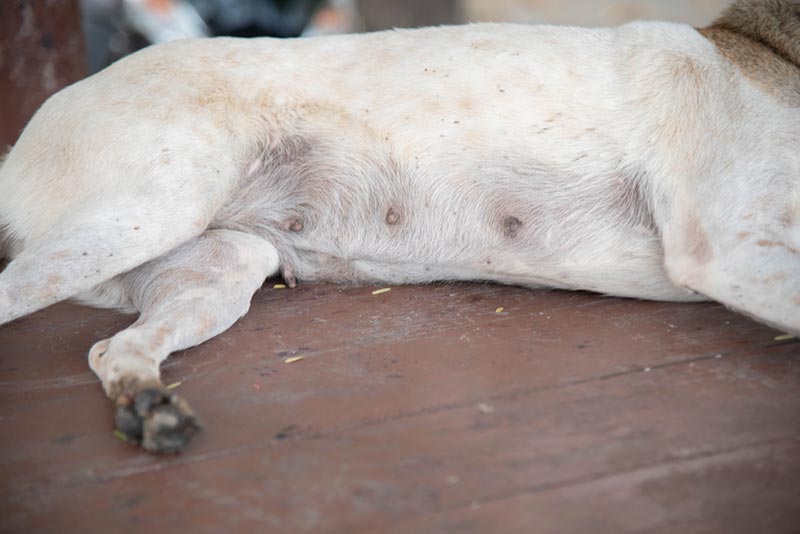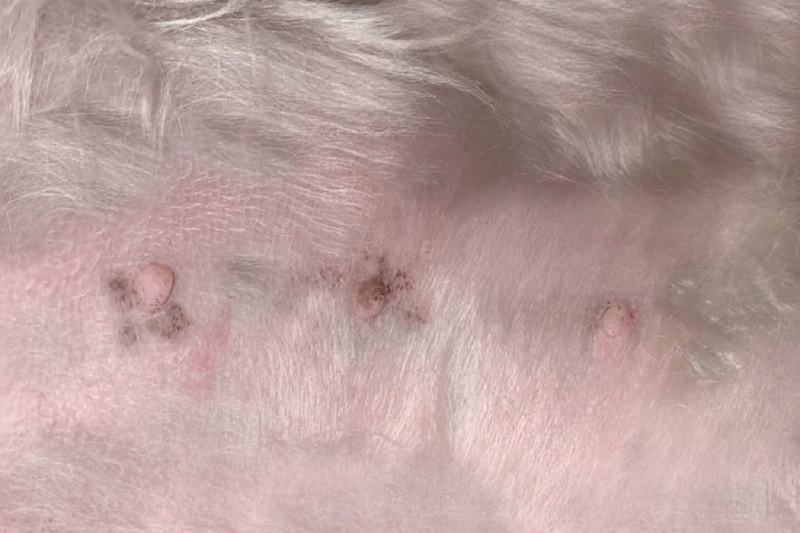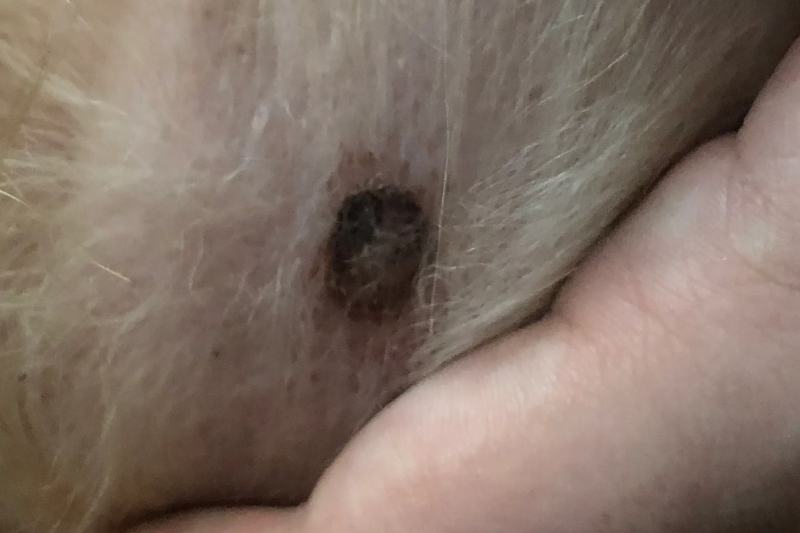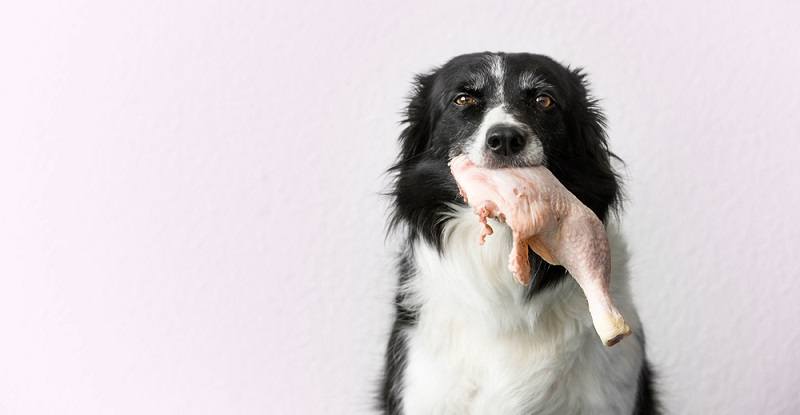Dog Scabs on Nipples: Causes, Symptoms, and Care (Vet Answer)
By Dr. Leigh Wilder, DVM (Vet)
Updated on

The word “scab” often conjures up memories of childhood, when scraped and scabbed elbows and knees were often the result of hours spent outdoors, playing with neighborhood friends. But what about our canine companions—how do dogs get scabs, and what could scabs affecting the nipples mean?
The following article will discuss scabs and crusts in canines, including potential causes, signs, and dangers associated with scabs in dogs. We will also review frequently asked questions regarding canine scabs and crusts, to help you feel prepared and knowledgeable should your dog require a visit to the veterinarian for further evaluation of this skin abnormality.
What Is a Scab?
A scab is a red, brown, or black-colored crust that forms at the site of a skin injury; while scabs can be unsightly, they are a normal part of wound healing.
After an injury, such as a cut or abrasion, bleeding from damaged blood vessels activates platelets, fibrin, and clotting factors. These different components work together to stop additional blood loss by forming a clot. As the clot dries, it turns into a scab that remains in place for several days to weeks to protect the underlying tissue while it heals. Once the wounded tissue has been repaired by the body, the scab will fall off on its own.
A term often used interchangeably with scab is a crust. A crust is formed when a variety of substances, such as blood, pus, or loose fragments of skin dry and adhere to the skin surface. While the two terms are similar, a scab is a type of crust and is the word most often used to describe the specific lesion formed after a traumatic wound.

What Are the Causes of Scabs?
Scabs or crusts can be located throughout the body and may be caused by a variety of different conditions. Potential causes of scabs or crusts on the nipples of dogs may include the following:
- Allergies and secondary infection. Allergies are a common cause of skin issues in canines. The three main types of allergies affecting dogs are flea bite allergies, environmental allergies, and food allergens. Dogs affected by these conditions are often seen scratching, chewing, or licking their skin; this repetitive trauma to the skin will often lead to secondary infection with either bacteria or yeast.
- Parasitic skin disease. Ectoparasites are parasites that live on the outside of an affected animal’s body. Examples of canine ectoparasites include mites, ticks, and lice. Ectoparasites often cause itching, however, this is not always present, depending on the specific ectoparasite causing the infection.
- Fungal skin disease. Yeast dermatitis, most often caused by infection with Malassezia pachydermatis, is a common skin condition in dogs, frequently seen secondary to allergies. Yeast dermatitis can occur in conjunction with a bacterial skin infection and may result in an unpleasant odor of the skin in affected dogs. Another fungal skin disease, dermatophytosis (commonly known as ringworm), may present with symptoms similar to yeast dermatitis. Canine ringworm is relatively uncommon, however, hunting dogs, free-roaming dogs, and young animals may be at a higher risk of infection.
- Mastitis. Mastitis is an inflammatory condition affecting the mammary glands of postpartum female dogs. Mastitis is often associated with bacterial infection, and risk factors for the development of this condition include trauma to the nipples caused by nursing puppies, living in unsanitary or dirty conditions, and systemic infection (infection affecting the entire body).
- Mammary tumors. Canine mammary tumors are common in intact females and female dogs that were spayed at greater than 2 years of age. Approximately 50% of mammary tumors in dogs are malignant, or cancerous. Surgical removal is usually considered the treatment of choice for canine mammary tumors.
What Are the Signs Associated with Scabs?
Scabs or crusts may be a variety of colors including red, brown, black, yellow, or white. These lesions may be noted anywhere on the body, including on or around the nipples. Crusts and scabs may tightly adhere to the underlying skin; however, loose or flaky crusts may also be noted.
Depending on the underlying disease process causing scabs or crusts, however, other clinical signs that may also be noted include:
- Licking, chewing, or scratching—often seen with allergies, parasites, bacterial infection, or fungal disease
- Changes to the skin including hair loss, redness of the skin, red or white bumps on the skin, thickened skin, or change in skin pigmentation—may also be seen secondary to chronic allergies, parasites, bacterial infection, or fungal disease
- Warm, swollen, or painful mammary glands—frequently seen with acute or non-septic mastitis
- Lethargy, fever, decreased appetite, and depression—may be present with advanced or septic mastitis
- Firm swelling under the skin near a nipple, nipple discharge, or ulceration of the skin over a mammary gland—may be noted in dogs with mammary tumors

What Are the Potential Dangers of Scabs on Nipples?
In general, scabs and crusts resulting from allergies, parasites, or skin infections are not considered dangerous. It is important to note, however, that some conditions, such as ringworm and sarcoptic mange are zoonotic diseases—meaning that they are transmissible from animals to humans.
In dogs with benign mammary tumors, surgical removal is often curative. Malignant mammary tumors, however, tend to have a poorer prognosis—both tumor type and the size of a mammary tumor may affect survival times in affected canines.
While canine mastitis can present with mild signs localized to the mammary glands, advanced mastitis secondary to bacterial infection may become life-threatening without aggressive treatment. Sepsis and septic shock are potential complications of mastitis, and occur when the body’s inflammatory response to infection leads to tissue damage, organ failure, a severe drop in blood pressure, and potential death. These conditions are considered medical emergencies and require immediate treatment.
Frequently Asked Questions (FAQs)
What testing is recommended for dogs with crusts or scabs?
If your dog has crusts or scabs, your veterinarian will likely recommend diagnostic testing for further evaluation. Skin tests, such as a skin impression, skin scraping, fungal PCR, or a fungal culture may be considered to evaluate for possible bacterial, parasitic, or fungal conditions.
If your veterinarian is suspicious of mastitis, they may recommend obtaining a sample of milk to perform bacterial culture and sensitivity; this determines the specific infectious agent present, as well as the appropriate antibiotic medication used to treat the infection.
How are scabs and crusts treated?
Treatment for scabs and crusts, whether on the nipples or elsewhere in the body, will depend on their specific cause. Crusts caused by bacterial or yeast infection, for example, may be treated with oral antibiotics or antifungal medications, topical therapy (such as medicated shampoos, sprays, or mousses), or a combination of these treatments.
Treatment for cases of mastitis may range from warm-packing affected mammary glands and encouraging frequent nursing, to treatment with antibiotic medication, and intravenous fluids for more advanced cases.
Conclusion
In summary, a wide variety of conditions may lead to scabs or crusts affecting the nipples of dogs. If you are concerned with scabs or crusts in your canine companion, a veterinary visit is recommended for further evaluation. An accurate diagnosis by a medical professional is essential in determining the appropriate treatment needed to get your dog on the path to recovery without delay!
Featured Image Credit: srimapan, Shutterstock














